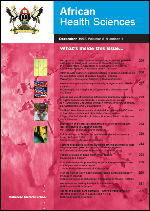
|
African Health Sciences
Makerere University Medical School
ISSN: 1680-6905
EISSN: 1680-6905
Vol. 16, No. 3, 2016, pp. 822-830
|
 Bioline Code: hs16104
Bioline Code: hs16104
Full paper language: English
Document type: Study
Document available free of charge
|
|
|
African Health Sciences, Vol. 16, No. 3, 2016, pp. 822-830
| en |
Determinants of alcohol use and khat chewing among Hawassa University students, Ethiopia: a cross sectional study.
Kassa,Andargachew; Wakgari,Negash & Taddesse,Fiker
Abstract
Background: Students’ alcohol and khat use have been associated with various health related problems. However, its magnitude
and associated factors among Ethiopian students are not yet well documented.
Objective: The study aimed to assess the prevalence of alcohol use, khat chewing and its associated factors among Hawassa
University students.
Methods: A cross-sectional study was conducted from June to July 2011. Multistage stratified sampling technique was employed
to select 590 students. Self administered questionnaires were used to collect data. Data was entered and analysed by SPSS version
20.0. Logistic regression analyses were used to identify the association of different variables.
Results: The current prevalence of student’s alcohol and khat use were 29.5% (95% CI: 25.8-33.3) and 16.3% (95% CI: 13.7-
20.0) respectively. Being male (AOR 1.8; 95% CI 1.1-3.0) and living alone (AOR 20.1; 95% CI 2.5-166.7) had a higher odds of
alcohol use. Similarly, family substance use history (AOR 4.8; 95% CI 2.5-9.3) and peer influence (AOR 4.6; 95% CI 2.3-9.0) had
also higher odds of khat use.
Conclusion and recommendation: The proportion of student’s khat chewing and alcohol use was significant. Hence, higher
education in collaboration with other stakeholders should work on convincing students about the ill effects of these substances.
Keywords
Alcohol use; cigarette smoking; university students; substance use; khat chewing
|
| |
© Copyright 2016 - African Health Sciences
|
|
